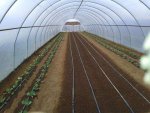Molim te reci mi informaciju koliko je to sulfata potrebno kupusu za nekakav prosječni prinos!?
Također, prihrana tj. gnojidba se ne može napamet govoriti, jer bez analize tla nema točnih podataka o potrebama kupusa!! Jedino što je sigurno je iznošenje hranjiva i to jedino može biti nit vodilja....
Dolje su navedeni svi makro i sekundarni elementi, ali ne vidim koliko je sulfata potrebno....:icon_idea:
6.2 Nitrogen
A soil analysis must be done to check the need for nitrogen. Excessive use of nitrogen has a bad influence on the environment and can
make the plant more vulnerable to diseases. The following table shows the average nitrogen dispensing in The Netherlands.
Crop Kg. N/Ha.
Headed cabbage 300
Brussels sprouts 350
Broccoli/Cauliflower 300
6.3 Phosphorus
Phosphorus is important for the root development of the brassicas, so it is important in the early stages of growth. This is why Phosphorus
is usually applied in the planting bed before planting. The following table shows the average Phosphorus dispensing in The Netherlands.
Crop Kg. Phosphorus / Ha.
Headed cabbage 80
Brussels sprouts 140
Broccoli/Cauliflower 80
A phosphorous deficiency can cause problems in Brussels Sprouts. The head of the plant will be affected by tip burn.
6.4 Potassium
The Potassium requirements of brassicas are quite high. Potassium is needed during the complete growth cycle, so it has a big effect on the
yield. Potassium is vital for transport of all the elements in the plant. If there is a shortage of potassium the evaporation will decline and
cause tip burn. The following table shows the average
Crop Kg. Potassium / Ha.
Headed cabbage 250
Brussels sprouts 100-350
Broccoli/Cauliflower 200
6.5 Magnesium
Brassicas do not require high amounts of Magnesium, The uptake of brassica is between 25 – 50kg. per hectare. The availability of
magnesium depends on the pH of the soil, if the pH is lower than 6,5 the plant loses the ability to extract Magnesium from the soil. The
amount of Potassium in the soil has an effect on Magnesium. Magnesium and Potassium are opposites, if there is a high level of Potassium
in the soil the level of Magnesium will automatically drop. The mineral is important for the leaf growth. If there is not enough Magnesium
available, leaves will start to turn yellow. This can be restored by additional fertilizing. Spraying the leaves with magnesium salt will clear
up the deficiency symptoms.
6.6 Boron
Boron is a trace element that is important for the development of the plant. If there is not enough available, deficiency disorders will occur.
These disorders are hollow stems in broccolis and headed cabbages. browning and rotting core in headed cabbages. These symptoms
cannot be restored before harvest. It is only possible to prevent the disorder for the next harvest. This means it is important to have a good
boron level before planting.
6.7 Molybdenum
Insufficient availability of Molybdenum will cause deficiency symptoms. Especially cauliflower is susceptible to Molybdenum deficiency.
The foliage will develop whip tailing with a prominent main vein. Molybdenum deficiency cannot be corrected by additional fertilizing.
The grower can only improve the molybdenum level to make sure the next harvest is not affected by this deficiency.

